Here is an in-depth explanation of the differences between oil paints and acrylic paints. Helpful for artists who are trying to decide which of these two wonderful mediums to explore. Depending on your studio space, your budget, your artistic goals and your painting style, one may be preferable to you than the other.
Of course the best way to learn is by doing. You will definitely learn a lot about painting and about yourself by trying both oil painting and acrylic painting!
Here is the transcript, for those who prefer reading to video:
I’ve been painting seriously for about 20 years. For approximately the first 10 years, I mostly used acrylics. For the second 10 years, I mostly used oils. So while we are all perpetually learning more, it’s safe to say that I’ve mastered both to the point of being able to talk about the differences.
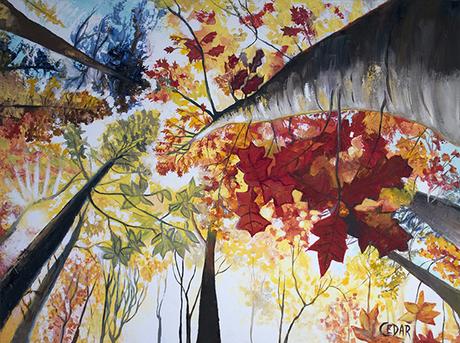
As of now, the year 2020, I switch it up with both but I’m gradually moving back towards acrylics. I absolutely love both of these mediums, but I will say they are very, very different and each come with their own learning curve. I highly recommend becoming proficient in both. It will make you a better painter with a deeper understanding of how to achieve what you want with your materials, regardless of what ends up being your preference.
Here are the main differences between oils and acrylics:
Drying speed
Oils dry slowly, over days or weeks.
The exception is quick-drying oils called “alkyds” but even those dry slower than acrylics.
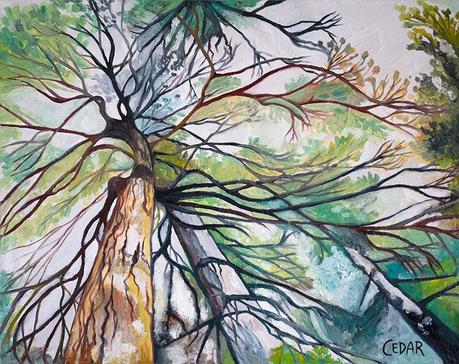
This is nice because there’s no rush to anything. You can start a painting and come back the next day and pick up where you left off, with the paint on your palette still wet and the colors on your canvas still wet enough to blend. You can achieve beautiful soft effects by using a large soft blending brush to blend colors together on your canvas, and take as much time as you need.
If you are a slow painter or you like more time to deliberate over decisions, you’ll probably like oils more because you have more time to mix colors. Because you have more time to play with mixing the colors, it’s much easier to create more subtle variations in your paintings with oils. That is a huge pro.
However, this also means it’s more difficult to not blend colors when you don’t want to. You always have to consider the risk of making things muddy or blurry when you want them to be clean and sharp. You may have to think more strategically because you have to let one layer dry completely before the next, if you don’t want things blended together.
Acrylics meanwhile dry in about 10 minutes to an hour at most.
The exception to this is if you’re using “open” acrylics or adding a retarder to your paint, which slows drying time. But oils will generally take longer to dry regardless.
Acrylics are good for you if you’re a bold and decisive, quick painter. The paints dry as you are mixing and applying them. This is a great thing IF it’s what you want!
Factors to consider: Richness of color and luminosity, variety of texture, ability to experiment, and your painting process
Acrylic colors darken slightly as they dry, while oils do not. The binder used in acrylics is white but dries clear—this makes the color look lighter to your eyes while you’re painting, but then darker as the painting dries and the binder turns clear. This can make it tricky to get a painting that “glows” with light the same way you can do with oils. This problem is even more pronounced the more acrylic polymer mediums you are mixing into your paint.
Oil colors are consistent from wet to dry. What you see is what you get! This is a plus because it’s easier to get the colors you want when mixing them.
With oils, transparent colors are more transparent and opaque colors are more opaque. Acrylics have more consistent properties across different colors.
When working with oils, you’ll probably find yourself becoming very intentional about using layering and glazing to achieve desirable effects.
There is something about the way light shines through thin glazes of oil color that is sensuous and beautiful. The luminosity you can achieve with oil glazes may be a subtle distinction from acrylics, but depending on your artwork, may be important to you.

One of the effects that’s easy to achieve with acrylics is hard lines and crisp edges. You can use tape to mask out areas, and you can paint sharp detail lines more quickly. This gives you a lot to work with in a much shorter time.
Acrylics also make it easier to achieve a variety of interesting textures if you take advantage of the variety of mediums available, from impasto effects to paint pouring—all of which dry quickly. You can play more with sculptural effects. Acrylics give you a more versatile toolbox when it comes to texture.
And with acrylics, your surface won’t crack over time no matter what reckless thing you decide to try. You have to be more careful with oils.
If you want to experiment with the viscosity of pigment or incorporate mixed media into your paintings, acrylics might be better for you.
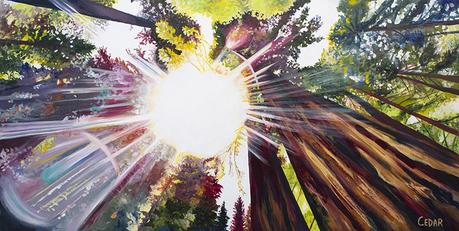
You can achieve similar interesting effects with oils, but it will take you days or weeks of waiting in between layers, and you have to be careful of the order you do things or you risk having cracks in your painting later.
To achieve an impasto effect with oils, I recommend playing with cold wax medium as your base layer, then layer over that with oil glazes if you wish.
Oil paints dry through a chemical reaction involving oxidation. The paint absorbs oxygen and actually expands as it dries. So if you apply a fast-drying color over a slow-drying color, you can end up with the surface of your painting developing cracks.
Acrylics don’t have this problem because as they dry, the water evaporates out of the paint and the paint shrinks rather than expanding.
So acrylics are more versatile, but subtle blending is much more difficult with acrylics. You either have to work very quickly, or add a retarder or slow-drying gloss medium to give you a little more time before the paint dries. You can also achieve a more blended look by working in multiple layers of very thin glazes, which takes a lot of practice to do skillfully.

If you want to use glazing techniques with acrylics, they make acrylic glazing mediums that can help you get a very similar effect to oils. You can get a beautiful result, but while working, it doesn’t feel quite the same as with oil glazes. Some people might prefer working with oils just because they feel different. Acrylics are more flat rather than luminous.
This is not a bad thing, it’s just different. With acrylics you end up thinking about layering in a different way. You can achieve similar effects, but the feeling of the medium, and the process, will be different.
With oils, you need to have a deeper understanding of your materials and follow a couple of rules: “thick over thin” and “fat over lean.” Fat here means more oil and lean means less oil.
As I mentioned, if the top layers of your painting dry before the bottom layers, then the top layers will crack. The thicker your application of paint, and the fatter (or oilier) your paint, the slower it dries. So, your bottom layers should be thinner, and have less oil in them and your top layers should be thicker and have more oil. You can break this rule, but if you do, you have to be extra careful that your painting is absolutely, completely dry between layers.
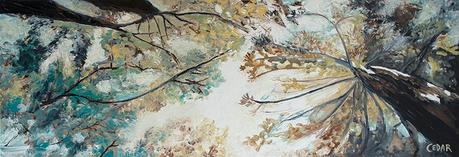
After your oil painting dries, it’s common to see some patches that are dull and matte compared to other parts that are shiny, because depending on your ground and your colors, some of the pigments absorb more oil than others. To fix this problem, it’s good to practice oiling out, or finishing your paintings with a very diluted coat of oil after they’re dry. Check out my other video for more info on how to oil out your oil paintings.
With acrylics, you don’t have to think about any of that. All the acrylic colors and mediums dry at the same rate and are inter-mixable with each other.
Despite the benefits of luminosity and easier blending, oils are definitely more complicated to master.
Standing the test of time
We know oils last for hundreds of years. We also know they become discolored over time. This is because the binder in oil paint, linseed oil, goes yellow over time. This is why old master paintings have that subtle golden glow to them. Acrylic polymer, on the other hand, does not yellow over time.
Acrylic paint is made of plastic. Acrylic polymer emulsion is tiny particles of plastic acrylic resin mixed with pigment and water. When you paint with it, the water dries out and the acrylic resin particles fuse together. The reason plastic is so harmful to the environment is that it takes forever to degrade. This is a good thing for your paintings!

We tend to believe this fallacy that reinforces a bias towards oils, that they are the more permanent medium because of all the amazing oil paintings we have from art history. While acrylics are too new for us to have a historical record of their staying power like we do with oils, accelerated aging tests in laboratories show that acrylics won’t fade in time and in fact will likely outlast oils in every measurable way, in the end. Acrylic colors should look the same as they do now after 200 years.
Oil paints dry stiffer and more brittle while acrylics are flexible. You have to be more careful about preparing your surface when working with oils. A rigid support like wood is safest in the long term, and if you’re painting on canvas with oils you have to be extra sure that your canvas is primed well. Because oil paints are more acidic, they can be corrosive to the underlying surface if not primed properly with gesso.
Another reason to take extra care with priming your surface with oils is if you have an unprimed surface, or a surface without a thick enough coat of primer, your surface may absorb too much of the oil out of your paint, which is one cause of your painting developing cracking later on.
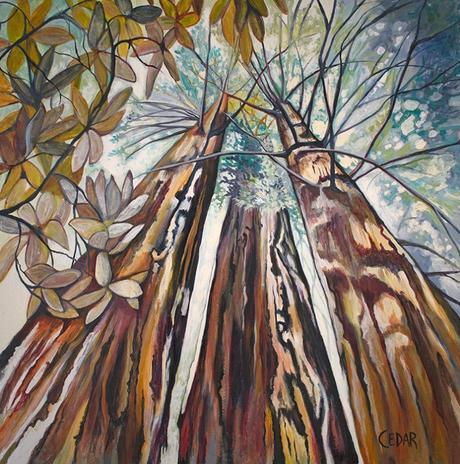
With acrylics, because they are more flexible, you can paint on paper, any fabric, any surface really, without worrying as much about your painting cracking, wrinkling or flaking in the future.
One thing to note is that acrylics are thermoplastic—they become harder in cold temperatures and softer and stickier in warm temperatures. While they won’t ever crack or flake the way oils will, the surface can still become damaged by exposure to heat.
Prestige and cost
There is a prestige associated with oil paintings because of the old masters.
While there is indeed something exciting about learning the same techniques those masters from history used, and I recommend you do, that doesn’t mean those materials and techniques are automatically better.
I think that if Leonardo da Vinci, Michelangelo, Rembrandt and Vermeer had access to acrylics at the time, they would have been stoked to work with them. This is something people don’t often think about—the old masters used oils primarily because that’s what they had available to them.
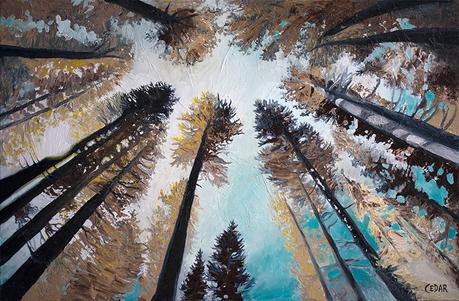
Oil paints and mediums are slightly more expensive than acrylics. Even though there are masterful things you can do with acrylics, there is still a stigma against acrylic painting. The idea persists that acrylics are on par with “student work.” This may be partially because acrylic paints and mediums are cheaper than oils, and it’s likely also because of a pervasive bias in favor of oils in art schools because of the legacy of the old masters using oils.
When acrylics were first invented, they were chalky and matte and the colors weren’t very vibrant. But over recent decades, as plastics technology has evolved, acrylic paints have evolved too and we now have vibrant, saturated colors to work with, as well as an impressive variety of acrylic mediums to achieve different effects. You shouldn’t let the pervasive bias towards oils stop you from playing with acrylics.

The prestige associated with oil paintings means they may sell more easily or for higher prices. This is something to consider if you’re looking for commercial success in selling your work, but ultimately, it’s a much less important factor than your creativity and your skill. In the end, what you do with your medium is always more important than which medium you use.
Toxicity and cleanup
With oil paints, you have to use volatile solvents which give off toxic fumes. I use Gamsol and other “odorless” solvents which are vastly preferable to mineral spirits which gives me an instant headache. However, even odorless solvents are not truly 100% odorless. If you’re sensitive to environmental toxins, you need to be careful with oil paint solvents in particular.
For a while I used water mixable oils, and while I did enjoy not needing toxic solvents, in the end, I decided I didn’t like them as much as traditional oils. In my experience, the texture of traditional oils is softer, creamier and just nicer to work with.
Acrylic paints are less toxic only because you don’t use toxic solvents with them. Otherwise, the pigments themselves are equally toxic, particularly cadmiums. The experience of painting with acrylics may feel less toxic to us because it’s the fumes that bother us. Ventilation is definitely more important when using oils. That said, you should take equal care about skin contact with the pigments, and obviously, avoid getting paint in your mouth whether oil or acrylic.

With oils, because the paint dries so slowly, you don’t have to clean your brushes right away. You can even leave them sitting in a little bit of oil until your next painting session. It’s nice not to have to deal with cleanup as frequently. But when you do clean your brushes, it’s more of a hassle and you have to use solvents, which are often toxic.
I recommend using solvent to get most of the paint out of your brush, then follow by cleaning it with The Masters brand brush cleaner and preserver. Murphy’s Oil Soap is also a good thing to have on hand for cleaning your oil brushes.
With acrylics, you have to clean your brushes fastidiously after every painting session, and sometimes in the middle of a painting session, because if you leave paint on them for any amount of time, it dries the bristles of your brush together and your brush is ruined. However, cleanup can be done with water alone and is a breeze, which is a huge plus.
One thing I like about acrylics is how easy and fun it is to peel the residue of dried paint off your palette. It comes off as a sheet of plastic. With oils, you need to scrape the paint off your palette before it dries. If paint does dry on your palette, to get it off you really have to put some muscle into it, using a sharp scraping tool.
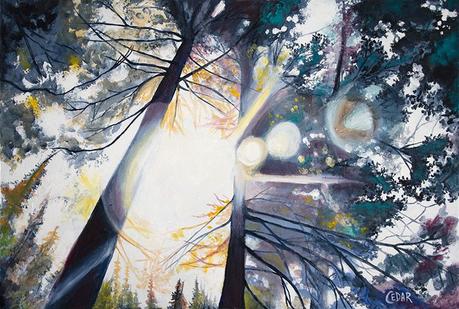
…To conclude, both of these mediums are very exciting and fun to play with. If you’ve only ever done one, I encourage you to try the other. And if you’re about to start learning how to paint for the first time, hopefully this info was helpful to you.
You could paint every day for your whole life and still have more to learn!
